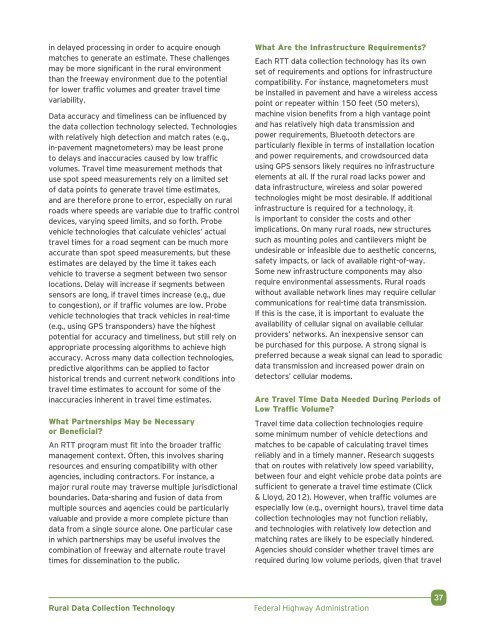Rural Data Collection Technology - FHWA Operations - U.S. ...
Rural Data Collection Technology - FHWA Operations - U.S. ...
Rural Data Collection Technology - FHWA Operations - U.S. ...
- No tags were found...
Create successful ePaper yourself
Turn your PDF publications into a flip-book with our unique Google optimized e-Paper software.
in delayed processing in order to acquire enoughmatches to generate an estimate. These challengesmay be more significant in the rural environmentthan the freeway environment due to the potentialfor lower traffic volumes and greater travel timevariability.<strong>Data</strong> accuracy and timeliness can be influenced bythe data collection technology selected. Technologieswith relatively high detection and match rates (e.g.,in-pavement magnetometers) may be least proneto delays and inaccuracies caused by low trafficvolumes. Travel time measurement methods thatuse spot speed measurements rely on a limited setof data points to generate travel time estimates,and are therefore prone to error, especially on ruralroads where speeds are variable due to traffic controldevices, varying speed limits, and so forth. Probevehicle technologies that calculate vehicles’ actualtravel times for a road segment can be much moreaccurate than spot speed measurements, but theseestimates are delayed by the time it takes eachvehicle to traverse a segment between two sensorlocations. Delay will increase if segments betweensensors are long, if travel times increase (e.g., dueto congestion), or if traffic volumes are low. Probevehicle technologies that track vehicles in real-time(e.g., using GPS transponders) have the highestpotential for accuracy and timeliness, but still rely onappropriate processing algorithms to achieve highaccuracy. Across many data collection technologies,predictive algorithms can be applied to factorhistorical trends and current network conditions intotravel time estimates to account for some of theinaccuracies inherent in travel time estimates.What Partnerships May be Necessaryor Beneficial?An RTT program must fit into the broader trafficmanagement context. Often, this involves sharingresources and ensuring compatibility with otheragencies, including contractors. For instance, amajor rural route may traverse multiple jurisdictionalboundaries. <strong>Data</strong>-sharing and fusion of data frommultiple sources and agencies could be particularlyvaluable and provide a more complete picture thandata from a single source alone. One particular casein which partnerships may be useful involves thecombination of freeway and alternate route traveltimes for dissemination to the public.What Are the Infrastructure Requirements?Each RTT data collection technology has its ownset of requirements and options for infrastructurecompatibility. For instance, magnetometers mustbe installed in pavement and have a wireless accesspoint or repeater within 150 feet (50 meters),machine vision benefits from a high vantage pointand has relatively high data transmission andpower requirements, Bluetooth detectors areparticularly flexible in terms of installation locationand power requirements, and crowdsourced datausing GPS sensors likely requires no infrastructureelements at all. If the rural road lacks power anddata infrastructure, wireless and solar poweredtechnologies might be most desirable. If additionalinfrastructure is required for a technology, itis important to consider the costs and otherimplications. On many rural roads, new structuressuch as mounting poles and cantilevers might beundesirable or infeasible due to aesthetic concerns,safety impacts, or lack of available right-of-way.Some new infrastructure components may alsorequire environmental assessments. <strong>Rural</strong> roadswithout available network lines may require cellularcommunications for real-time data transmission.If this is the case, it is important to evaluate theavailability of cellular signal on available cellularproviders’ networks. An inexpensive sensor canbe purchased for this purpose. A strong signal ispreferred because a weak signal can lead to sporadicdata transmission and increased power drain ondetectors’ cellular modems.Are Travel Time <strong>Data</strong> Needed During Periods ofLow Traffic Volume?Travel time data collection technologies requiresome minimum number of vehicle detections andmatches to be capable of calculating travel timesreliably and in a timely manner. Research suggeststhat on routes with relatively low speed variability,between four and eight vehicle probe data points aresufficient to generate a travel time estimate (Click& Lloyd, 2012). However, when traffic volumes areespecially low (e.g., overnight hours), travel time datacollection technologies may not function reliably,and technologies with relatively low detection andmatching rates are likely to be especially hindered.Agencies should consider whether travel times arerequired during low volume periods, given that travel<strong>Rural</strong> <strong>Data</strong> <strong>Collection</strong> <strong>Technology</strong>Federal Highway Administration37
















